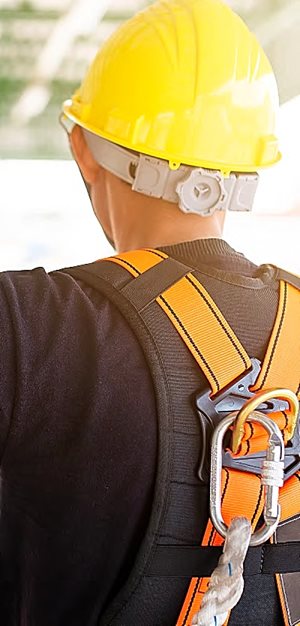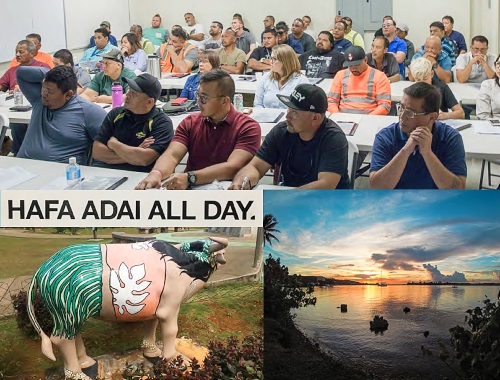6 June 2022
UC San Diego OTIEC Offers Lifesaving Fall Protection Training in US Pacific Islands
 With the help of a prestigious federal training grant, UC San Diego Extended Studies is bringing OSHA instruction to workers on remote Pacific islands whose lives and safety depend on it. Instructors are teaching fall prevention and protection strategies, extending the reach of Extended Studies' Occupational Safety and Health (OS&H) Department 6,000 miles away to American Samoa, Guam, Saipan, and Rota (CNMI).
With the help of a prestigious federal training grant, UC San Diego Extended Studies is bringing OSHA instruction to workers on remote Pacific islands whose lives and safety depend on it. Instructors are teaching fall prevention and protection strategies, extending the reach of Extended Studies' Occupational Safety and Health (OS&H) Department 6,000 miles away to American Samoa, Guam, Saipan, and Rota (CNMI).Serving as a complement to the instruction offered through UC San Diego's OSHA Training Institute Education Center (OTIEC), the OS&H Department was one of 90 U.S. organizations to receive a 2020 Susan Harwood Training Grant. The grant is awarded to nonprofits and universities to build and extend the scope of OSHA-standard health and safety education, often in underserved communities.
"There was a critical need for this training," says UCSD Extended Studies instructor Dan Mooney, who wrote the grant application. "We had been alerted by a hospital in Saipan of the large number of construction-related injuries they had treated: amputations, burns, and fractures." The territory, which is part of the Mariana Islands, had several fatalities in recent years — a fall from a ship gangway, in a hotel elevator shaft, and from a construction scaffold. "For such a small population, this represents a high rate of work-related deaths."
Working in hazardous industries and occupations fraught with high fatality rates, the population in these faraway islands has been particularly vulnerable. Unlike other territories, American Samoa does not have an OSHA office to offer safety and health training and on-site consultation visits. With low profits and low wages, employers and workers in the islands cannot afford to bring in trainers from the U.S. mainland. Immigration policies in the region also prevent many workers from traveling since doing so can lead to losing their visas or standing in citizenship applications.
The OS&H Department had planned to teach in person in these distant U.S. territories, but the pandemic made this impossible. Amid COVID-19, travel to the islands was shut down. When OSHA decided to allow online training for the first time in its history, UC San Diego Extended Studies quickly regrouped to teach the fall prevention and protection course to the islanders virtually, starting in May.
"What struck me was how incredibly appreciative the students were to receive the training," says instructor Van Howell, who worked with the team to tailor the four-hour sessions to the specific industries represented: maritime, construction and hospitality, among others. The students varied in their exposure to fall protection protocols, with some novices and others more experienced.
Howell has 35 years of safety experience, including working in OSHA leadership. During their stints with OSHA, Howell says, "Dan Mooney and I have seen fatalities — the result of improper use of fall protection equipment — so we could relay these important lessons. Some students were shocked to learn how far you can fall from an anchorage point, for example. So, we taught them how to take into account the height of the worker and the length of the self-retracting line, not just count on being safe tying off 17-and-a-half feet away."
 In American Samoa, where WiFi quality is not always reliable, the students gathered in a classroom with steady internet service to take the virtual live online class. Fall protection gear was provided so that students could practice putting it on. "We had a lot of interaction and storytelling," Mooney shares. "They were very surprised to learn how easily safety lines can be severed, for example, with the edge of a steel building and the force generated from a fall. They learned the importance of using lines that can withstand leading-edge falls."
In American Samoa, where WiFi quality is not always reliable, the students gathered in a classroom with steady internet service to take the virtual live online class. Fall protection gear was provided so that students could practice putting it on. "We had a lot of interaction and storytelling," Mooney shares. "They were very surprised to learn how easily safety lines can be severed, for example, with the edge of a steel building and the force generated from a fall. They learned the importance of using lines that can withstand leading-edge falls."This is the second Harwood grant the UCSD Extended Studies OTIEC programs have received to teach workers in the Pacific Rim. In 2018, as the islands were cleaning up and rebuilding after two super typhoons, nearly 500 workers were offered both classroom instruction and on-the-street remediation when hazards were observed.
With travel restrictions lifting this fall, the instructors hope to get a Harwood grant extension — at no cost to the university — to pursue in-person courses and meet their original goal of 340 workers trained.
Ken Keberle, the third instructor on the team, hopes they can continue this initiative. "It taught me a lot as an instructor, seeing how vital the course was to these workers. I saw the enormous value of the Susan Harwood training grant. And I gained a lot of respect for the reach of UC San Diego, that we could bring expert instruction to such an underserved part of the world."
To learn more about OSHA training courses and programs at UC San Diego Extended Studies, visit osha.ucsd.edu.